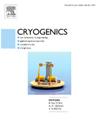Bundle effect on a helical coil in liquid nitrogen with pool boiling for liquid oxygen densification
IF 1.8
3区 工程技术
Q3 PHYSICS, APPLIED
引用次数: 0
Abstract
The need to densify oxidizers using cryogenic fluids is increasing to enhance the performance of launch vehicles. One of the most practical methods for oxidizer densification is heat exchange cooling between liquid oxygen and liquid nitrogen, typically using a tube bundle heat exchanger. Due to the multiple tubes in the bundle, a bundle effect arises, which enhances convective heat transfer by inducing liquid agitation from bubble generation and rising. This paper presents experimental results and prediction models that account for bubble behavior in a tube bundle. The experiment is conducted with saturated liquid nitrogen in a pool at atmospheric pressure and helical coil-type heat exchangers instead of a traditional tube bundle stack heat exchanger. Liquid oxygen densification is achieved by varying mass flow rates and inlet temperatures. Single-passage helical coils made of copper are used to minimize uncertainty from maldistribution flow and reduce thermal resistance compared to convective heat transfer coefficients in the inner and outer tubes. The coils, with an outer diameter of 12.7 mm, were tested in both vertical and horizontal directions and with various coil pitches. The bundle effect was clearly observed under helical coil conditions, and the experiment confirmed that the convective heat transfer coefficient increased with increasing heat flux and bubble generation rate. The prediction models considering bubble behavior—rising and generation rate—were validated by comparison with experimental results. The forced convective Nusselt number, experimentally measured to range from 23 to 361 through its correlation with the Boiling Reynolds number, closely followed the predicted correlation curve of the bubble generation model. It demonstrated a mean absolute error of 83.3, a standard deviation of 65.6, and an average relative error of 64.8 %. These values show improved accuracy compared to the relative errors of two predicted curves in the bubble rising model: 216 % for the single circular tube correlation and 381 % for tube bank correlations. This improvement suggests that the increased bubble generation rate with heat flux is better reflected for liquid oxygen densification with a helical coil submerged in large-scale static pool condition.
液氮中螺旋线圈的束流效应与液氧致密化的池沸效应
为了提高运载火箭的性能,使用低温液体对氧化剂进行增密的需求日益增加。最实用的氧化剂增密方法之一是在液氧和液氮之间进行热交换冷却,通常使用管束式热交换器。由于管束中有多根管子,因此会产生管束效应,通过诱导气泡产生和上升产生的液体搅拌来增强对流传热。本文介绍了考虑管束中气泡行为的实验结果和预测模型。实验是在大气压力下,使用池中的饱和液氮和螺旋盘管式热交换器(而不是传统的管束叠加式热交换器)进行的。通过改变质量流量和入口温度来实现液氧致密化。使用由铜制成的单通道螺旋盘管,可最大限度地减少因流量分布不当而产生的不确定性,并与内外管中的对流传热系数相比减少热阻。对外径为 12.7 毫米的线圈进行了垂直和水平方向的测试,并采用了不同的线圈间距。在螺旋盘管条件下,明显观察到了管束效应,实验证实对流传热系数随着热通量和气泡产生率的增加而增加。考虑到气泡行为--上升和生成率--的预测模型通过与实验结果的对比得到了验证。通过与沸腾雷诺数的相关性,实验测得的强制对流努塞尔特数在 23 到 361 之间,与气泡生成模型的预测相关曲线密切相关。其平均绝对误差为 83.3,标准偏差为 65.6,平均相对误差为 64.8%。这些数值表明,与气泡上升模型中两条预测曲线的相对误差相比,精度有所提高:单根圆管相关性的相对误差为 216%,管组相关性的相对误差为 381%。这一改进表明,在液氧致密化过程中,浸没在大规模静态池条件下的螺旋线圈能更好地反映随热流量增加而增加的气泡产生率。
本文章由计算机程序翻译,如有差异,请以英文原文为准。
求助全文
约1分钟内获得全文
求助全文
来源期刊

Cryogenics
物理-热力学
CiteScore
3.80
自引率
9.50%
发文量
0
审稿时长
2.1 months
期刊介绍:
Cryogenics is the world''s leading journal focusing on all aspects of cryoengineering and cryogenics. Papers published in Cryogenics cover a wide variety of subjects in low temperature engineering and research. Among the areas covered are:
- Applications of superconductivity: magnets, electronics, devices
- Superconductors and their properties
- Properties of materials: metals, alloys, composites, polymers, insulations
- New applications of cryogenic technology to processes, devices, machinery
- Refrigeration and liquefaction technology
- Thermodynamics
- Fluid properties and fluid mechanics
- Heat transfer
- Thermometry and measurement science
- Cryogenics in medicine
- Cryoelectronics
 求助内容:
求助内容: 应助结果提醒方式:
应助结果提醒方式:


